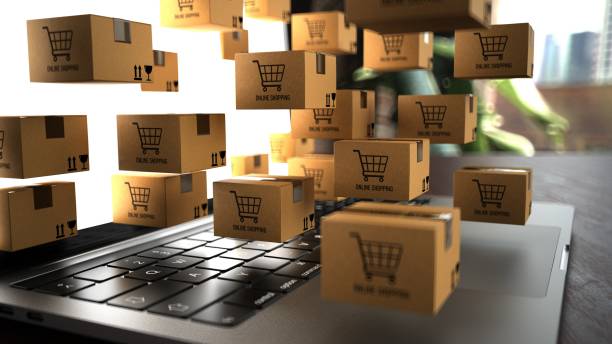You know how much you love online shopping. Clicking around, adding items to your cart, entering your credit card – it’s addicting. But have you ever wondered about all the work that goes on behind an ecommerce website to make your shopping experience seamless? From web design to inventory management, fulfillment to customer service, there are so many moving parts. That’s why you need to check out this fascinating ecommerce infographic breaking it all down.
With colorful graphics and bite-sized facts, it will give you a peek behind the curtain at everything that makes ecommerce possible. After seeing the ecommerce infographic, you’ll have a whole new appreciation for that t-shirt arriving at your door in 2 days flat. So set aside 5 minutes and dive into this visual guide to the ecommerce universe. We guarantee you’ll come away impressed.
Overview of Ecommerce and Key Stats

Ecommerce has revolutionized the way we shop. No longer limited to brick-and-mortar stores, people can now buy almost anything online. In 2020, ecommerce sales made up 14.1% of all retail sales worldwide.
The Rise of Ecommerce – Ecommerce Infographic
Ecommerce has grown exponentially over the past decade. In the U.S. alone, ecommerce sales have risen from $231 billion in 2012 to over $790 billion in 2020. The COVID-19 pandemic further accelerated this trend, with more people shopping online to avoid crowds.
Key Players
Some of the largest ecommerce companies are household names like Amazon, eBay, and Alibaba. Amazon reigns supreme, capturing 38% of U.S. ecommerce sales. While Amazon started as an online bookstore, it now sells everything from groceries to gadgets. eBay, on the other hand, acts as a middleman connecting buyers and sellers. In China, Alibaba is the dominant ecommerce platform, with hundreds of millions of product listings and over 750 million users.
What’s Next for Ecommerce
Ecommerce will continue growing as retailers enhance the online shopping experience. Virtual and augmented reality, personalization, and voice commands will make shopping more engaging. Same-day delivery and in-store pickup options will also become more widespread. At the same time, concerns over data privacy and job disruption pose challenges for the ecommerce industry to address. Overall, ecommerce has revolutionized retail and will shape how we shop for years to come.
The Evolution of Ecommerce Over the Years – Ecommerce Infographic

Ecommerce has come a long way since the 90s. Back then, it was a novelty and people were hesitant to buy things online.
The Rise of Amazon
Amazon launched in 1995 and helped revolutionize ecommerce. They made it easy to buy books, music and eventually almost anything online. As more people got comfortable shopping on Amazon, other retailers launched their own ecommerce stores.
The Dot Com Bubble Burst – Ecommerce Infographic
Around 2000, hundreds of new ecommerce companies launched but many quickly failed. This “dot com bubble burst” slowed ecommerce growth for a few years.
The Mobile Revolution
When the iPhone launched in 2007, it transformed ecommerce again.
People could now shop whenever and wherever they wanted using their phones. Retailers rushed to optimize their sites for mobile, and apps like Instagram and Pinterest made it easy to discover and buy new products on your phone.
Social Commerce and One-Click Checkout
On platforms like Instagram and Facebook, social media influencers and brands can tag products in their posts. Interested shoppers can then buy the product without leaving the app. One-click checkout options on many sites also make impulse purchases dangerously easy.
Ecommerce has evolved at a breakneck pace and completely reshaped how we shop. While ecommerce still only makes up about 15% of total retail sales, that number grows every year. The ecommerce revolution is here to stay.
Ecommerce Infographic Breakdown – What the Data Shows – Ecommerce Infographic

Shoppers are going digital
According to the ecommerce infographic, over 2 billion people made purchases online last year. That’s a huge number and it shows how ecommerce has become ingrained in the way we shop. Many of us now turn to our phones, tablets, and computers first when we’re looking to buy something instead of visiting a brick-and-mortar store. Ecommerce is convenient, offers a huge selection, and lets us shop on our own schedule.
Mobile reigns supreme – Ecommerce Infographic
An astonishing 72% of ecommerce sales now happen on mobile devices like smartphones and tablets. If your business isn’t optimized for mobile shopping, you’re missing out on a major opportunity. People want to be able to browse products and complete purchases quickly and easily using their mobile devices. Make sure you have a responsive mobile-friendly website or dedicated mobile app for the best customer experience.
Global ecommerce is booming
Ecommerce sales are growing all over the world, especially in developing markets. The ecommerce infographic shows huge growth in countries like India, China, Brazil, and Mexico. If you sell products that would appeal to international customers, it may be worth exploring how to tap into these fast-growing markets. You’ll need to consider things like translation, currency exchange, shipping, and any country-specific regulations or taxes. While global ecommerce does add complexity, the potential for increased sales and new customers makes it very appealing.
The data and insights highlighted in this ecommerce infographic demonstrate how ecommerce has fundamentally reshaped the way we shop. Businesses that want to compete need to focus on mobile-optimized experiences, personalization, convenience, and global reach. Ecommerce is the future of retail, and the future is here.
Conclusion: Ecommerce Infographic
So there you have it, an in-depth look at the state of ecommerce today. From explosive growth numbers to changing consumer habits, this infographic highlights all the key stats you need to know. Whether you’re an entrepreneur looking to tap into online shopping or an analyst trying to understand industry trends, studying these facts and figures paints a clear picture.
Ecommerce is only going to get bigger and continue disrupting retail as we know it. Adapt or get left behind, those are your options. But with the right info like this infographic provides, you can strategize how to harness the ecommerce boom rather than become a victim of it. Knowledge is power, so use it wisely to stake your claim in this brave new online marketplace. That wraps up our deep dive into the world of ecommerce today through this comprehensive infographic.
For more helpful articles, you can browse our blogs.







